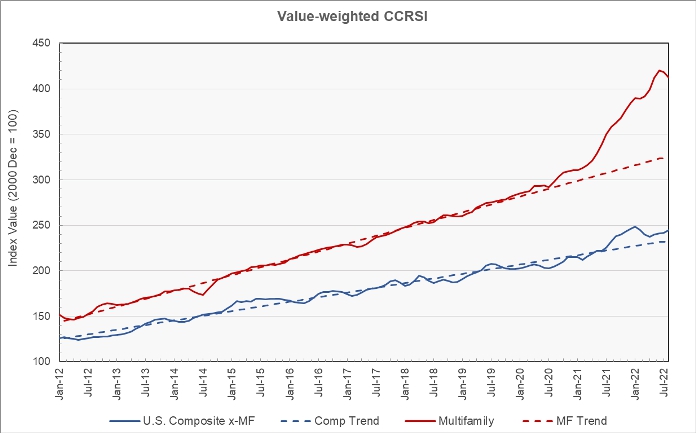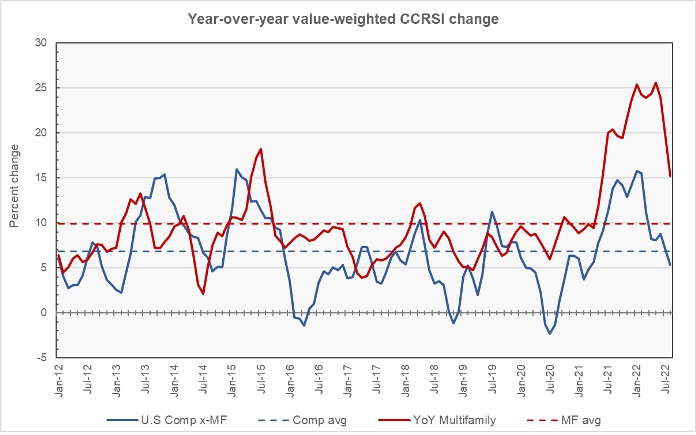CoStar reported that its value-weighted index of multifamily property prices fell 1.4 percent month-over-month in August after a revised fall of 0.5 percent the month before. The index increased 15.2 percent year-over-year.
The combined value-weighted index of non-multifamily commercial property rose by 5.4 percent, year-over-year, in August. This index rose 1.4 percent month-over-month. The other commercial property types tracked by CoStar are office, retail, industrial and hospitality.
For more information on the CoStar Commercial Repeat Sales Indexes (CCRSI’s), see the section at the bottom of this report.
Comparing property types
The first chart, below, shows the history of the value-weighted CCRSI’s since January 2012 for multifamily property and for all other commercial property considered as a single asset class. It also shows trend lines for the growth in the two CCRSI’s for the period from January 2012 to January 2020. The indexes are normalized so that their values in December 2000 are set to 100.

The chart shows that, as the pandemic roiled the economy, both price indexes deviated from the remarkably steady pattern of growth that they had exhibited in the prior 8 years. This effect was especially pronounced for multifamily property whose price index was as much as 23 percent above the trend line in June. The price index for non-multifamily property is now 5.1 percent above the trend line after being as high as 8.5 percent above the trend line as recently as January.
The second chart shows the year-over-year change in the value-weighted multifamily property price index and that for all other commercial property types since January 2012. It also shows the average rates of annual price growth for the two property classes over that time.

The chart shows that the year-over-year rates of increase for both property classes have been falling in recent months. However, the rate of increase for multifamily property is still well above its recent average while that for other commercial property considered as a single class has fallen below its recent average.
The annual increase in multifamily property prices has been 9.9 percent while that of other commercial property prices has been 6.8 percent. For comparison, MSCI, another provider of transaction data, reports that the average annual increase in multifamily property prices has been 11.1 percent while that of other commercial property has been 8.5 percent.
Transaction volumes reported to fall again
CoStar reported that number of repeat-sale transactions were down about 9 percent in August from the revised level of the month before. However, the transaction level decline for July was revised upward from a fall of 27 percent to a fall of only 22 percent as more transactions for the month were identified. Transaction dollar volume was also down from July’s revised level, falling 13 percent to $14.2 billion as July’s transaction dollar volume was revised upward from $15.9 billion to $16.4 billion.
The full report discusses all commercial property types, but detailed data on each of the property type and regional data are only reported quarterly and so are not included in this month’s report. While the CoStar report provides information on transaction volumes, it does not break out multifamily transactions. The August CoStar report can be found here.
CCRSI defined
The CoStar report focuses on a relative measure of property prices called the CoStar Commercial Repeat Sales Index (CCRSI). The index is computed based on the resale of properties whose earlier sales prices and sales dates are known. The index represents the relative change in the price of property over time rather than its absolute price. CoStar identified 1,619 repeat sale pairs in August for all property types. These sales pairs were used to calculate the results quoted here.
CoStar computes CCRSI’s for a variety of property groupings, combining them by cost, region, property type or other factors. The value-weighted index is more heavily influenced by transactions of expensive properties than is CoStar’s equal-weighted index. The value-weighted index is the focus of this report because it is an index whose value is reported monthly and for which CoStar breaks out multifamily property as a separate category.













